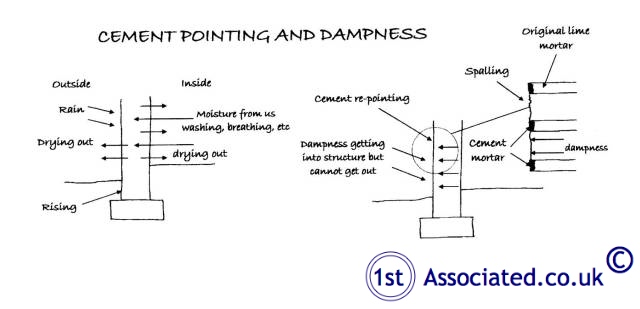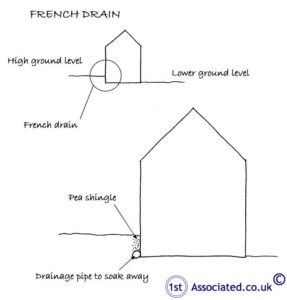Damp surveying to a
different standard
Our surveyors are independent therefore we are not linked to or owned by an estate agent or lending institute, and as a result we are only working with your best in terests in mind. Since we are solely surveyors, we can keep our overheads down and ultimately our prices as well.
terests in mind. Since we are solely surveyors, we can keep our overheads down and ultimately our prices as well.
We give quotes on all our surveys. We complete our reports quickly and feel the quality of our surveys are one of the best on the market. We offer a reasoned view, based upon our knowledge and experience. Equally if we think the property has problems we will explain this in a clear, concise manner. We also use sketches, photographs and digital images to clarify what we are saying.
Having a building survey carried out on the property that you intend to buy will give you the extra peace of mind that you are buying the right one.
We also offer specific defects reports, damp reports, valuations (not for mortgage purposes).
Please Free phone us on 0800 298 5424 and surveyor will call you back.
Free phone 0800 298 5424
Damp proofing companies that aren't specialists!
Many companies in the damp proofing industry refer to themselves as damp proof specialists. From what we have seen over the years the last thing they are is specialists, with their primary motive being to sell damp proof treatment, and certainly their service isn't free and is hidden within the costs, usually in the many thousands carrying out the recommended repair work, which we would argue, in most cases, is not necessary at all.
Independent Damp Surveyors
However, as with any industry there's always the good, the bad and the ugly. We have heard reports that there are a few companies out there that are truly giving independent advice, like ourselves, and we were pleased recently to meet one of them.
Paul F. Morris, Abbey Independent Surveys
We were pleased to bump into another independent surveyor recently when carrying out a building survey on quite a complex property.
 When we arrived the Assistant Surveyor, who has been with us a few years, came out to say that he was amazed at what he saw was going on, as there was a damp surveyor in the building literally taking it to bits and turning the kitchen into a chemistry lab! When we got to the house it was a slight exaggeration that he was taking it to bits, but he certainly was opening up the floors and analysing pieces of timber, and we were very pleased to introduce ourselves.
When we arrived the Assistant Surveyor, who has been with us a few years, came out to say that he was amazed at what he saw was going on, as there was a damp surveyor in the building literally taking it to bits and turning the kitchen into a chemistry lab! When we got to the house it was a slight exaggeration that he was taking it to bits, but he certainly was opening up the floors and analysing pieces of timber, and we were very pleased to introduce ourselves.
Literally only a week before we had been at a presentation by Jeff Howell, ex-bricklayer, chartered builder and chartered building surveyor, now a writer of books and writer of regular articles in the Sunday Telegraph, together with his website askjeff.co.uk, who was presenting on the Rising Damp Myth. He spoke very highly of Paul F. Morris of Abbey Independent Surveys, both at the presentation and in his book.
We were very pleased when chatting with Paul F. Morris that his experience over the many years of analysing rising damp and penetrating damp, together with woodworm was very similar to ours and whilst dampness and woodworm only makes up part of our building survey (also known as a structural survey) Paul F. Morris' specialism in this area is that he can really focus on any problems and rising damp really is a problem, but the problem is more to do with how people, including surveyors and also damp proof specialists, analyse and investigate the dampness, particularly based on the damp meter, commonly known by its generic trade name of Protimeter, correctly known as an electrical conductivity meter.
Rising damp that isn't rising damp
We had a good discussion about the rising damp that we haven't found over the years! We had both come across many examples of mis-diagnosis of dampness. We have come across everything from leaking gutters that have been blamed for rising damp, to high ground levels, and a very good example at the property we met at was there was a soil and vent pipe that was cracked to the rear and was leaking water into the structure. However, it had been diagnosed by an estate agent, and, of course, the estate agent's damp proofing specialist company as being rising damp. It wasn't it was the broken soil and vent pipe (the soil and vent pipe is the pipe that takes the waste water away from the toilets, showers and wash hand basins, etc).
Traditional building survey / structural survey against a damp inspection
A structural survey (now also known commonly as a building survey) looks at the whole of property rather than just the damp areas. It gives a priority to problems in the building as a whole with the costly items or major items being priority, along with any structural problems, insurance problems, etc, etc, The dampness side is, of course, a very important part of the building survey but can be overlooked or given a cursory superficial examination.
Paul F. Morris has, however, taken investigation to a different level. If you discuss it with him he will advise you that at one time all damp surveys were carried out along similar lines to the way he carries them out, and indeed he advises that of the biggest companies used to give two year training before they allowed anyone to go out and investigate the dampness, looking at many of the types: rising damp, penetrating damp (also known as lateral dampness) and of course condensation.
Today, rather than using common sense, general knowledge and a multitude of other skills surveyors and damp proofing specialists (although we are not sure whether they deserve that name) use electrical conductivity meters, known as damp meters or Protimeters. Anyone that knows anything about them knows that they are very inaccurate in relation to identifying dampness in materials, because, as the name suggests, they are electrical conductors, which can only be used with common sense and good building knowledge, built up over many years.
However, like us, the use of the damp meter is only one thing that Abbey Independent Surveys use. They use all the following techniques:
Speedy meter (calcium carbide) test
Gravimetric/Hygroscopic testing
Chemical analysis for nitrates and chloride (soluble salts)
Thermo-hydrometer analysis
Deep probe electrical conductivity surface salt analysis
During the course of our conversations we were pleased to say that we agreed with the majority of the issues and more interestingly when talking to Paul F. Morris we commonly came across the same problems and these were, for example:
Common Damp Related Problems
Cement Mortar Pointing
We were pleased to see that generally the recommendations followed those that we had made externally; that the hard cement based mortar is stopping the property from breathing. The hard cement mortar had been repointed over the original soft lime based mortar.

Soil and vent pipe and gutters and downpipes
There are general leaks from these pipes, for example to the back of the soil and vent pipe where it rusts and cannot be painted and deteriorates first, or cracks, allowing water into the structure.
Airbricks acting as gutters
We often see airbricks acting as gutters. This is usually where the ground level has been increased by the adding of paving slabs or a tarmaced area, or a general build up of the garden border. We favoured the use of a French drain in this situation, which can lower the ground level around the airbricks; please see the sketch below. We would stress that French drains do have to be carried out correctly so they don't become French ponds! Please see our article on this.

Leaking radiators and other pipes
We have also come across dampness that comes from leaking radiators; again no rising damp diagnosed as rising damp, and also in some cases with no damp at all, being diagnosed by damp specialists as rising damp!
The damp proof specialists also usually offer woodworm treatment; both of them require chemicals and this is after all what they are selling.
The key words are active woodworm
When looking for woodworm it is very important to see if the word active is used, as most good houses will have woodworm of some sort or another, whether it is active is a completely different story. Unfortunately, timber specialists (again we are not sure whether they are sure they should have this title) write a report, we would say, in a way that implies that woodworm is active, or a statement to be on the safe side that it should be treated (and in some cases we have seen it re-treated every year which is just utter nonsense).
Paul F. Morris of Abbey Independent Survey was able to test the timber to see whether it had been treated before and he said that generally he finds that timber has not been treated, but it doesn't stop the woodworm treatment specialists from treating it again!
So, how do our building surveys differ from Abbey Independent Surveys?
We were pleased to say that we carry out some of the tests that Abbey Independent Surveys do, although not all of them, although having seen them in action we will be increasing the number of tests that we do.
We would add that we are not specialist in the same way as they are, and have no way of competing with them, as we look at the whole property and give advice on the priorities, together with the action required and the appropriate costs. Most importantly we too are independent surveyors.
Independent surveyors
For independent expert opinion from an independent surveyor you need to employ someone that it in the Independent Surveyors and Valuers Association (ISVA) who is able to, and will gladly comment on, damp issues, rising damp, penetrating damp and lateral dampness, condensation, surveys, building surveys, structural reports, engineers reports, specific defects report, structural surveys, home buyers reports, dampness, damp proof courses, damp proofing companies or any other property matters please free phone 0800 298 5424 for a friendly chat with a surveyor call back.
Independent commercial property surveyors
If you have a commercial property, be it leasehold or freehold, then you may wish to look at our Dilapidations Website at www.DilapsHelp.com and for Disputes go to our Disputes Help site www.DisputesHelp.com .
We hope you found the article of use and if you have any experiences that you feel should be added to this article that would benefit others, or you feel that some of the information that we have put is wrong then please do not hesitate to contact us (we are only human).
The contents of the website are for general information only and is not intended to be relied upon for specific or general decisions. Appropriate independent professional advice should be paid for before making such a decision.
All rights are reserved the contents of the website are not to be reproduced or transmitted in any form in whole or part without the express written permission of www.1stAssociated.co.uk
